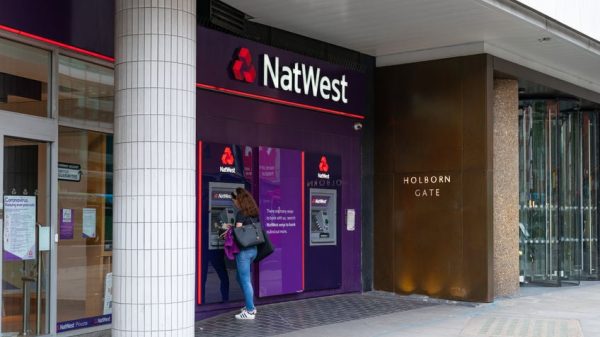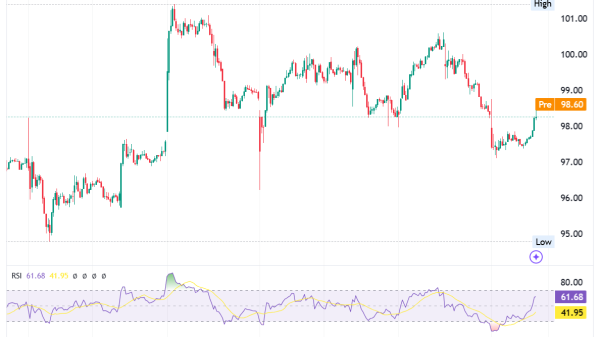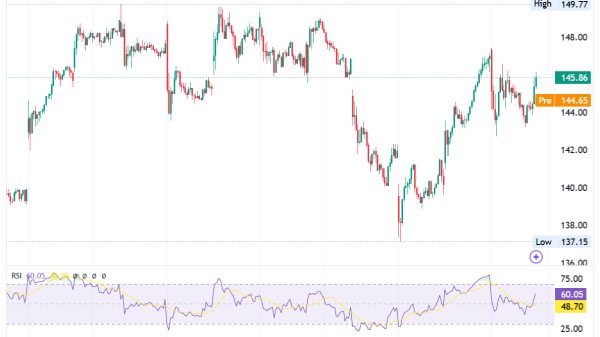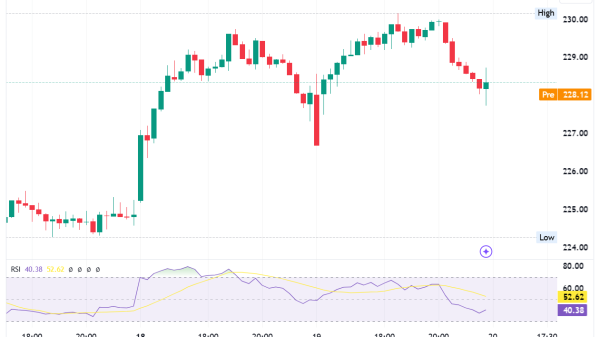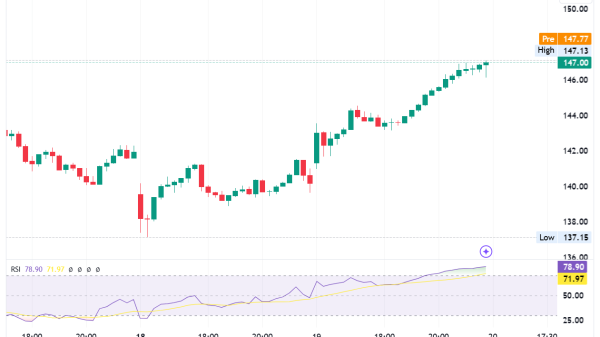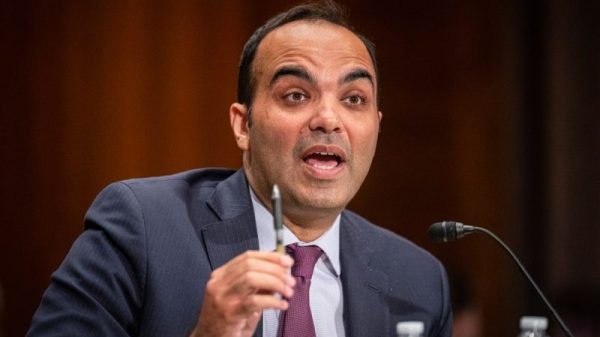
Cadence Bank (CADE) reported a solid performance in its third-quarter 2024 earnings call on October 30, 2024, with GAAP net income reaching $134.1 million, or $0.72 per diluted share. Adjusted net income from continuing operations saw a 6% increase from the previous quarter, amounting to $135.6 million, or $0.73 per share.
The bank’s core customer deposits grew over 11% annually, despite a slight uptick in deposit costs. Cadence Bank also showcased a stable credit quality and a strong capital position, with a CET1 ratio of 12.3%. Looking ahead, the management team is optimistic about maintaining growth in loan originations and improving net interest margins.
Key Takeaways
- GAAP net income for Q3 stood at $134.1 million, with $0.72 earnings per diluted share.
- Adjusted net income from continuing operations increased by 6% quarter-over-quarter.
- Core customer deposits grew by over 11% year-over-year, reaching approximately $985 million.
- Loan balances remained flat due to payoffs; however, new loan commitments were strong.
- The net interest margin improved for the fourth consecutive quarter to 3.31%.
- The bank repurchased over 323,000 shares and maintains a strong capital position.
- Management is optimistic about the future, with a focus on loan originations and net interest margins.
Company Outlook
- Revenue growth is expected to outpace expense growth into 2025.
- The bank plans to continue its share buyback strategy.
- Potential M&A opportunities are being evaluated post-election, with interest in expanding within existing markets.
Bearish Highlights
- Loan growth has been under pressure due to payoff activities.
- Competitive pressures may affect deposit costs, though they are expected to peak this quarter.
Bullish Highlights
- The average rate for loans set to reprice within the next year is 6.34%.
- Management expects to manage down deposit costs going forward.
- There is a healthy loan pipeline and strategic hiring efforts are in place.
Misses
- Certain transactions expected to close by the end of the quarter did not materialize, although the pipeline remains strong.
Q&A Highlights
- Management discussed the impact of non-accrual loans, primarily from SBA and FHA credits, but expressed no significant concerns over collection issues.
- Cadence Bank plans to call $215 million in subordinated debt in November, which will temporarily reduce Tier 2 capital.
- The company is actively recruiting, with a focus on normalizing expenses.
- Loan yields are expected to adjust in response to market changes, with new loans originating at around 7.70% to 7.75%.
- Non-interest income is projected to increase if mortgage rates decrease.
In summary, Cadence Bank has demonstrated a strong performance in the third quarter of 2024, with growth in core customer deposits and a stable credit quality. The bank’s outlook remains positive, supported by a robust loan pipeline and strategic initiatives. Management remains focused on operational efficiency and is cautiously optimistic about the bank’s prospects in the face of competitive market conditions.
Full transcript – Cadence Bancorp (CADE) Q3 2024:
Operator: Good morning, and welcome to the Cadence Bank Third Quarter 2024 Webcast and Conference Call. All participants will be in listen-only mode. [Operator Instructions] After today’s presentation, there will be an opportunity to ask questions. [Operator Instructions] As a reminder, this conference is being recorded. I would now like to hand the call to Will Fisackerly, Director of Corporate Finance. Please go ahead.
Will Fisackerly: Good morning, and thank you for joining the Cadence Bank third quarter 2024 earnings conference call. We have members from our executive management team here with us this morning, Dan Rollins (NYSE:ROL), Chris Bagley, Valerie Toalson, and Billy Braddock. Our speakers will be referring to prepared slides during the discussion. You can find the slides by going to our Investor Relations page at ir.cadencebank.com, where you’ll find them on the link to our webcast or you can view them at the exhibit to the 8-K, that we filed yesterday afternoon. These slides are also in the Presentations section of our Investor Relations website. I would remind you that the presentation, along with our earnings release contains our customary disclosures around forward-looking statements and any non-GAAP metrics that may be discussed. The disclosures regarding forward-looking statements contained in those documents apply to our presentation today. And now I’ll turn to Dan for his opening comments.
Dan Rollins: Good morning. Thank you for joining us to discuss our third-quarter 2024 financial results. After I’ve covered a few highlights and Valerie provides additional detail on our financials, our executive management team will be available for questions. We are proud to report third quarter results that reflect continued positive momentum for our Company. GAAP net income was $134.1 million, or $0.72 per diluted common share with adjusted net income from continuing operations for the third quarter of $135.6 million, or $0.73 per diluted common share, an increase of $0.04 or 6% compared to the second quarter of ’24. From a balance sheet perspective, our deposit performance was a real highlight for the quarter. Our teams across the footprint have done a great job of retaining and expanding our deposits, resulting in significant growth in core customer deposits, over 11% on an annualized basis, while holding deposit costs essentially flat, up just 2 basis points in the quarter. We also generated meaningful new loan commitments, although loans were flat for the quarter as payoff pressures offset the growth due to active capital markets activities creating paydowns as companies sell or refinance in permanent markets. Looking to the rest of the year, we are optimistic that our new loan originations will outpace the payoff pressures as our loan pipeline remains robust and diverse and the economies in our footprint are performing very well. With stabilized deposit cost and continued upward repricing of loans also drove our fourth consecutive quarter of improvement in our net interest margin to 3.31%, up 4 basis points from last year. Importantly, credit quality continued to remain stable and in line with our expectations. Our net charge-offs were consistent with the prior quarter and we maintained a solid allowance for credit losses at 1.38% of loans. While we did see an increase in non-accrual loans, primarily as a result of migration of a handful of previously criticized credits, our criticized and classifieds level have remained relatively consistent as a percent of loans during the year, and we are not seeing signs of concern or weakness. We are also pleased with our continued performance and operating efficiency, as reflected in our adjusted efficiency ratio of 57.7% for the quarter. As expected, our total expenses did increase as a result of merit increases as well as a few items that benefited our second quarter expenses. Valerie will dive into these details as well as our expectations more in just a moment. Finally, we again took advantage of the market swings and repurchased just over 323,000 shares of our stock. Our capital metrics remain strong, including CET1 of 12.3%, and total capital of 14.5% as of September 30th. And finally, our tangible book value per share increased by $1.60, while our tangible equity to tangible assets ratio ended the quarter at 8.28%. I’ll now turn the call over to Valerie for her comments.
Valerie Toalson: Thank you, Dan. It is good to be here this morning discussing another great quarter for Cadence Bank. As Dan mentioned, we reported adjusted EPS from continuing operations of $0.73, up 6% from the second quarter of 2024 and up 37% from the same quarter last year. The adjusted items for the third quarter were minor, only a $0.01 net EPS impact, and included a $1.2 million reduction of the FDIC special deposit assessment estimate, and $2.9 million of securities losses we adjusted certain portfolio positions. As Dan noted, deposit growth was a real highlight for the quarter. Total deposit growth was approximately $985 million for the quarter, or 10.4% annualized. As laid out on slide four, this included growth of core customer deposits of $1.4 billion, offset by declines in public funds. The core customer growth consisted of approximately $775 million in interest-bearing deposits and $600 million in non-interest-bearing, of which $435 million was in temporary inflows of customer balances at quarter-end that swept out the next day. Even excluding the impact of the temporary inflows, our non-interest-bearing deposits as a percent of total deposits was stable in the quarter at 22.7%, and the teams did an incredible job of retaining maturing time deposits and building customer balances. Loan balances were essentially flat for the quarter with net declines in non-real estate C&I, offsetting about a 2% overall loan growth again in our other loan segments as we ended the quarter with a loan-to-deposit ratio of 86%. The impact of the balance sheet activity on our margin continued to be positive as we increased net interest income by $5.1 million in the quarter to $361 million, and our net interest margin increased compared to last quarter by 4 basis points to 3.31%. Slide 10 details our steady improvement in net interest margin over the last year. Compared to the third quarter of last year, our net interest margin has increased 33 basis points and our net interest income has grown 10%. Even with the decline in SOFR in the third quarter, we continued to see increasing loan yields as only 29% of our loans are floating-rate with about half of those being prime-based. The combination of new fundings and variable loan repricing’s and renewals coming on at rates higher than the overall portfolio led to our yield on-net loans improving 5 basis points in the third quarter to 6.64%. As Dan commented, our deposit costs have really stabilized even with the balance growth increasing only 2 basis points to 2.55% for the third quarter. Additionally, average loans increased approximately $335 million linked-quarter, funded by securities cash flows, which further improved the mix of interest-earning assets. The third quarter also benefited from our retirement of $139 million of sub-debt at the end of the second quarter, and we have another $215 million in sub-debt with the 4-plus percent coupon that we plan to call in November. Additionally, we paid down $1.5 billion of our BTFP borrowings with excess cash just earlier this month. We expect to repay the remaining $2 billion of BTFP during the fourth quarter, replacing it ideally with core deposits supplemented with wholesale sources as needed. Overall, due to all of these factors, we expect continued improvement in our net interest margin in the near term even with the forward curve interest-rate reduction expectations. Non-interest revenue highlighted on slide 12 was $88.8 million on an adjusted basis, increasing $3.2 million, or 3.7% in the third quarter as broad-based fee growth was softened by a decline in mortgage banking revenue. The quarter’s increase in deposit service charges of $1.1 million was primarily in account analysis fees, and the increase in other non-interest revenue of $7.1 million, excluding the gain on sale of businesses in the second quarter. Included growth in credit-related fees, customer swap fees, SBA income, and other miscellaneous revenue really across the board. These increases were partially offset by a $5 million decline in mortgage banking revenue in the third quarter as changes in the rate environment combined with payoffs and paydowns resulted in a mortgage servicing rights valuation adjustment of a negative $7 million. This was offset by mortgage production and servicing income of $8.2 million, reflecting growth of 3% compared to the prior year’s quarter. Stepping back to a year-over-year perspective, total adjusted non-interest revenue had solid growth during the year, up 10% compared to the same quarter in 2023. Moving on to expenses. Total adjusted non-interest expense was just over $260 million for the quarter, up $9.2 million, or 3.7%, which was expected given the July 1st annual merit cycle, as well as the tailwinds of several items impacting second quarter expenses favorably. As laid out on slides 13 and 14, compensation costs increased $4.3 million compared to the second quarter on an adjusted basis that is due almost entirely to the merit cycle impact. Legal expense increased $2.9 million, and other miscellaneous expenses were up $3.9 million linked-quarter, with both increases simply a result of those lower second quarter expenses that included legal, fraud, and operational loss recoveries as well as other benefits that were unique to the second quarter. On an overall basis, we continued to experience solid broad-based expense management, resulting in the quarterly efficiency ratio of 57.7%, and our year-over-year reduction in quarterly adjusted expenses of 1.5%. Given our strong expense management and our outlook for the remainder of the year, we are updating our full-year 2024 adjusted expense guidance to a range of down 1% to 3% compared with the 2023 full-year. While very pleased with the reduction in expenses this year, we continue to invest in our growth, teams and technology and expect a more normalized expense growth rate to resume for 2025. Turning to credit results detailed on slides eight and nine. Net charge-offs for the third quarter were $22.2 million, or 26 basis points annualized, down slightly from the 28 basis points in the second quarter. A significant portion of these charge-offs were previously specifically reserved and we recorded a provision for credit losses for the third quarter of $12 million, bringing our ACL coverage to 1.38% at the end of the quarter. Non-accrual loans increased by $56 million in the third quarter, and as a reminder, $82 million, or 30% of our $273 million in non-accrual loans represent guaranteed portions of SBA and FHA credits. We don’t expect collection issues with the guaranteed balances, but while they are in process, they do weigh negatively on our non-accrual criticized and classified balances. Even so, our classified and criticized loans as a percent of total loans has been relatively consistent through the year. Classified loans as a percent of total loans were flat at 2.09% linked-quarter and criticized loans increased slightly in the third quarter to 2.64%, but tracked lower than the same quarter last year. Our capital detailed on slide 15 continues to build and remain strong, supporting growth and the ability to be opportunistic. Dan mentioned this quarter’s share repurchases. Year-to-date, we have repurchased 1.2 million shares at a weighted average price of under $27. I commented earlier on our plans to call our $215 million in subordinated debt in November. This debt is currently included in Tier 2 capital, so that will create a slight dip in Tier 2 in the fourth quarter, but we anticipate that to be temporary and replaced in the near term through ongoing earnings growth. In closing, it really was a positive quarter for our Company and it was particularly pleasing to see the very strong deposit growth results, both in terms of growth as well as in managing costs. Beyond that, our net interest margin and fee businesses have continued to grow, credit remains stable and in line with our expectations, and our teams have just done a fantastic job in improving operating efficiency over the year. We are optimistic and working hard to continue this momentum throughout the remainder of 2024 and into 2025. Operator, we would like to open the call to questions, please.
Operator: Thank you. We will now begin our question-and-answer session. [Operator Instructions] Today’s first question comes from Manan Gosalia with Morgan Stanley. Please go ahead.
Manan Gosalia: Hey, good morning, all.
Dan Rollins: Good morning, Manan.
Manan Gosalia: I wanted to go through some of the puts and takes on NIM in the near term versus the medium term. So maybe to start on the asset side. Can you talk about how we should think about the net impact of the floating-rate loans repricing in the near term? Plus it looks like you have some variable-rate loans that you have coming due at a higher rate over the next one to 12 months. How should we think about that? And then finally, the fixed-rate loan piece that you have repricing over the next year, because it seems like you’ve got a nice uptick in loan yields again this quarter despite rates not being up.
Valerie Toalson: Yes, I’m happy to take that. And I would just point you all attention to, we did have a correction on that slide 11 that has our repricing maturity, and so there is an updated slide deck that was posted this morning that details out related categories of the rates. But you’re exactly right, our loan yields did continue to tick up even in spite of having 27% loading rate securities, and that again is because the overall portfolio at 6.41%, we’re putting on the new loans at rates higher than that. We also have loans that are variable-rate or fixed-rate that are considering repricing or renewing coming back in at higher yields. And so when you take a look, you mentioned that coming on three to 12 months, the weighted average rate of the loans that are to reprice over the next three to 12 months is 6.34%. We’re putting on loans higher than that today. And so it’s that incremental bump that we believe will continue to support loan yields increasing modestly as we look forward over the coming quarters.
Manan Gosalia: Got it. So you’re saying even the variable-rate loans reprice at a slightly higher rate than what they are on the books at today?
Valerie Toalson: Yes, absolutely, because they’ll come on, and effectively they’re yielding the rate today, but when they come on for repricing, it’s market pricing.
Manan Gosalia: Got it.
Dan Rollins: So variable rate is going to reset, just going to reset further out than instantly.
Manan Gosalia: Understood. And then maybe on the liability side, you noted that you paid down some BTFP, you have more BTFP payments coming up. How should we think about deposit betas on the downside given your comments that you would eventually want to replace that BTFP with core deposits?
Valerie Toalson: Yes. So you likely noticed that we have a deposit cost increase of 2 basis points this quarter. Of course, the rate declines that did come in the quarter were late in the quarter. So I would expect that this quarter is actually our peak in deposit costs. We are working aggressively to be able to bring those deposit costs down and still continue to have the growth in deposits that we saw this quarter. That is on some of the exception prices, et cetera, that we’re working hard on that. The other factor that I think is important to note is that we had over almost $1 billion or $3 billion rather in time deposits that renewed this quarter. We’ve got another $3.5 billion — $3.6 billion that renew next quarter. Fair?
Dan Rollins: Next quarter is the fourth quarter.
Valerie Toalson: Yes. And then fourth quarter. Thank you, Dan. Yes. I forget my quarter-end. And they’re actually at just shy of 5%, and so those will reprice at a lower rate, depending on the term that they come on and renew at. And so there is a little bit of tailwind for the repricing of some of that CD book that is coming up over the next three to six months.
Manan Gosalia: Got it.
Dan Rollins: Appreciate the question.
Manan Gosalia: So — yes. Thank you. And just to clarify in terms of the deposit betas and the downside. So what do you think you should get over the next couple of quarters?
Valerie Toalson: Yes. We’re at this — the rates just started coming back down so we’re kind of in that new cycle of reporting deposit betas. I’m not sure we’re ready to talk about a specific number there other than we are working hard to be as aggressive as we can to bring those down while retaining deposits. So a little more on that I think as we come into the coming quarters.
Manan Gosalia: Appreciate it. Thank you.
Operator: The next question comes from Brett Rabatin with Hovde Group. Please go ahead.
Brett Rabatin: Hey, good morning, everyone. I wanted to ask first just on — Dan, I know you mentioned the strong loan pipeline. Can you guys talk about the level of commitments maybe linked-quarter and then maybe just gross versus net for 3Q in terms of actual production?
Dan Rollins: Gross versus net. So — yes. So we saw new loans coming on in the quarter was a $1.7 billion-ish, and it was — that’s pretty close to where we were in 2Q, and the pipelines are full. Chris and Billy are both sitting right here. I mean, the team is busy. We are running hard. I think we’re winning a lot of business. We just can’t keep it on the balance sheet. It comes and gets paid off too fast. Billy or Chris? Bill?
Billy Braddock: Yes. So a couple of segments. Energy being the primary one where we’ve had more churn than normal midstream specifically. In the quarter alone, we had almost $200 million in kind of refinances paydowns, and that has a lot to do with the M&A market and bond market activity that slowed some, but our origination activity has not. So what Dan pointed to is pipeline activity in that space specifically has been real robust. We just haven’t kept up with the paydowns, but I think over a period of quarters, we will and we will catch up more broadly and just general corporate C&I specifically. And we saw some of the same. It’s more M&A activity driven that has created payoffs of our existing borrowers, but pipelines are filling back up, it’s just any given point in any given quarter, it might be up or down. At the end of last quarter, it was flat.
Brett Rabatin: Okay, that’s helpful. Yes, that’s helpful. And then just on the guidance for total adjusted revenue. When you think about the margin being a little better going forward, I was surprised — I totally agree with the change in the expense guidance, but I was a little surprised you didn’t tweak higher maybe the total adjusted revenue number higher. If the margin is going to expand in the fourth quarter, is there anything that would not have that 5% to 8% be on the higher end of that range, you know, fee income? Is there some other component that I’m missing on that?
Valerie Toalson: I think that that’s certainly a possibility. I tend to still be a little bit conservative, I would say, on where we may end up with deposit costs. There’s a lot of competition out there in deposits, but I do think that all else being equal, if we continue to see the trends that we’re seeing, then the higher-end range of that is not to be unexpected.
Brett Rabatin: I’m sorry, Valerie, the higher range is not to be unexpected.
Valerie Toalson: Yes. Yes. I think that’s a reasonable assumption.
Brett Rabatin: Okay, great. Fair enough. Thanks for all the color.
Dan Rollins: Thank you, Brett.
Operator: The next question is from Catherine Mealor with KBW. Please go ahead.
Catherine Mealor: Good morning, Catherine.
Catherine Mealor: Thanks. Great quarter. Good morning. I wanted to ask, Valerie, you mentioned that you think expense growth should normalize next year. We can put a big range around what normalized means. Is there any way to narrow that kind of conversation and maybe talk about it relative to revenue growth, or what kind of level do you think is an appropriate level of expense growth?
Dan Rollins: We agree. It’s hard to know what normalized is. We agree with that statement. I think we look at what inflation is doing to us. We’re continuing to invest in our franchise. We’re continuing to invest in our people. We’re looking at the inflation rates. I don’t know that we have a number today, Valerie, you may have more color than that.
Valerie Toalson: Yes. No, I think that does it well. And we’ll be updating our expectations for the overall income statement as we report next quarter as we look into 2025. But normal and in — we don’t anticipate the declines that we saw this year, but we’re normalized with inflation and with continuing to obviously, invest in our teams and technologies.
Catherine Mealor: Great. So — and it’s fair to assume as we move into next year if your margin is expanding maybe at a moderate pace, but still expanding and the origination volume you’re seeing continues to drive loan growth, and then mortgage rebounds and all that. There’s — it’s fair to assume that we should be in an environment in 2025 where revenue growth is faster than expense growth. Is that fair?
Dan Rollins: I think that’s fair.
Catherine Mealor: Okay, great. Thanks for the clarity. Appreciate it. It’s a great quarter, guys. And thanks for the new slide too.
Dan Rollins: Thank you, Catherine.
Catherine Mealor: Yes. Thanks for the new slide too, Valerie. I was panicking over the variable-rate loan declining so thank you for refiling that.
Operator: The next question is from Michael Rose with Raymond James. Please go ahead.
Michael Rose: Hey, good morning, guys. Thanks for taking my questions. Maybe just following up on the expense question. We’ve heard more and more banks talking about kind of leaning in on hiring efforts in order to kind of drive some additional loan growth next year. Can you just talk about maybe your hiring pipelines and if you’d expect that to be kind of a greater contributor to kind of a normalized expense growth next year as we think about it and what that impact might be? Thanks.
Dan Rollins: Yes, Michael, I appreciate that. I think the question is, what’s normalized that? It’s been so many years that hasn’t been normal. What’s normalized is the question for everyone. And we certainly are hiring people. We’ve got a big leader on the ground in a couple of markets. We’ve got a leader on the ground in Fort Worth that just joined us we’re excited about and we continue to look for and we think we’ve got people in the pipeline that you call to come on board here in the near future. But I don’t think there’s anything outsized. I think that I would call that just normal investing in our franchise. I don’t think there’s anything that we would call out that says we’re going to hire this big team of people that are going to do something. That’s not been our normal process. We haven’t seen that opportunity present itself. That doesn’t mean in the middle of next year that that’s something doesn’t come up. But right now, that’s not what we’re looking for. We’re not plugging that into budgeting numbers as we look forward. I think normalized for us, it’s going to be inflation on most things and we’re going to continue to invest in technology and we’re going to continue to invest in our people.
Michael Rose: Helpful. And maybe just as my follow-up. Obviously, nice build in the capital this quarter, you guys bought back some shares. The earn-back on the buyback though is getting up a little bit higher after the recent move in kind of all-bank stocks, which has been nice to see. But can you just outline your near-term buyback appetite? And then how should we think about the prospects of M&A as we move forward, especially once we get past the election? Thanks.
Dan Rollins: Yes. No, that’s two different questions. So buyback, we’ve been consistent all year long on the buyback. You’ve seen us do the same thing three quarters in a row. The market has hiccupped in some way. We’ve backed up and we’ve taken advantage of that. Our buyback is in place. We’ve got an annual process that we roll through on our buyback program and I would think that we continue to play value in the same rules that we’ve been playing, and I don’t think we change anything there. On the M&A front, there continues to be conversations. I think we continue to be one that would like to see expansion in footprint. We continue to see more opportunities or we continue to see more announcements with footprint expansion and that’s less attractive to us. We would like to grow within the footprint. You’ve heard me talk for a while, we would like to grow in the markets we’re already in. And in no particular order, we’d like to get bigger in Tampa and Orlando and Nashville and Atlanta and Houston, Dallas, Austin and Chattanooga, and we can — I can go on and on with the markets that we serve today where we would like to be bigger within those markets. So that’s where we’re focused and we’re having conversations. I don’t know that anything comes about immediately, but we want to be in the game. And we think today from where we’re trading capital-wise, where we sit from a capital number, we think we’re sitting in a really good spot to be able to execute.
Michael Rose: All right. That’s a good list of markets there so I think you’ll have lots of opportunities. Thanks, guys for taking my questions.
Dan Rollins: Thank you.
Operator: The next question comes from Ben Gerlinger with Citi. Please go ahead.
Ben Gerlinger: Hi. Good morning.
Dan Rollins: Hi. Good morning, Ben.
Ben Gerlinger: I was curious if we could kind of just talk through about loan yields a little bit more here. I know you kind of answered it originally. So we just had a 50 basis point cut. Market is projecting a few more here in the next six months. Just kind of curious like how responsive have loan yields been to the most recent 50? Has everything priced in? And kind of going forward, any sort of color you can give a little bit more granular on kind of new loan yield rates or anything to that extent?
Dan Rollins: Yes. So dollars pulling that one up, but we’ll start on page 11. We break it out that way on purpose. The floating rate that shows the $9 billion — $9.1 billion, 27% of the portfolio at 8.06%, that’s virtually instant change within 30-day change.
Valerie Toalson: Yes. Yes, within 30 days. You’re right because it’s both prime and life or end of SOFR.
Dan Rollins: That’s right. Yes, so that’s going to happen very short. That $9 billion is going to change very quickly. The variable-rate structure that’s behind it, some of that could change in the next quarter, some of it could change a couple of years out. So that’s a much longer variable-rate reset process. And the fixed-rate, that $8.7 billion in fixed-rate, some of that’s going to mature in this quarter and get repriced also. So some of each — mostly all of the floating-rate stuff will reprice this quarter if rates change and some of the other two quarters will reprice. So that’s why we’re breaking it out the way we’re showing it to you that way.
Valerie Toalson: And if you look back at this past quarter, the new loans came on at around a 7.70%, 7.75% level what we’re seeing come in.
Dan Rollins: And remember, the rate change was late in the quarter.
Valerie Toalson: Yes, definitely.
Dan Rollins: So a lot of that was before the rate change.
Valerie Toalson: Yes. No, that’s a fact. Yes, and the spreads have been pretty wide, but I would expect that they probably come in a little bit more than some of the rates would actually.
Ben Gerlinger: Got you. Okay. That’s helpful.
Valerie Toalson: Is that helpful?
Ben Gerlinger: Yes, yes. No, that’s a lot of color. I appreciate that. And then on fee income. So I get the MSRs accounting and you have really no insight into that until someone accounting tells you what it’s going to be, but then if you back-out securities gains, you kind of get to the — let’s call it 95-ish — $96 million. Is that a fair run-rate like-kind of backing into here is core or excuse me, is other sustainable? Is $96 million a good kind of starting point for next year as a base, or is there something that we might be missing here behind the scenes?
Valerie Toalson: Yes. I mean we had a good solid performance. I mean, if you set aside the MSR, but I will say, if rates do come down, we expect the mortgage revenue to actually pick up on the production side of things and the ability to sell those into the markets and drive some non-interest income. So I would expect that, that’s one variable that’s really going to be rate dependent. Included in other NII, that’s was a little elevated this quarter compared to some of the prior quarters. I mentioned a slew of other items kind of miscellaneous positive move in a variety of categories. It can bounce around a little bit quarter-to-quarter. I mean, it can bounce around $5 million for a quarter or more simply because there’s some fair valuation that occurs within those numbers. Some of our FBIC investments, we have some other funded investments that get fair-value quarter-to-quarter so it can impact that and that’s a little harder to predict. But other than that, we feel really good about our non-interest income. The various sources, the wealth teams are doing well. Like I said, the interest rates and the mortgage, we anticipate that that should see some uptick as we look forward.
Dan Rollins: The mortgage team is queued up for success. As we look at one of the things we’ve invested in this year is the mortgage team has done a good job of making sure that we’ve got great producers on the ground. They’re ready to roll. If rates up, the door opens for them. We’re going to be able to harvest some mortgage revenue. On the wealth management side, the team is doing a fantastic job there. We’re clearly asset-priced. So if there’s a change in valuation, we would be impacted there. But right now, things look really good on both of those lines of business.
Ben Gerlinger: Got you. Okay, sounds good. I appreciate the color. Thanks.
Dan Rollins: Thanks, Ben.
Operator: Thank you. The next question comes from Matt Olney with Stephens. Please go ahead.
Matt Olney: Hey, thanks. Good morning, guys. I want to go back to the expected paydown of this bank term funding program in the fourth quarter. It sounds like a portion of this is going to be from just holding lower levels of overnight liquidity. And I think that overnight liquidity level has been between $2 billion, $3 billion for most this year, but it was below $2 billion last year. So trying to appreciate if we should be assuming lower levels of overnight liquidity next year once we see the full impact of this BTFP paydown.
Dan Rollins: Yes, I think that’s a fair assumption because we were actually earning dollars by holding what was out there. We were earning more on cash than we were paying for it, and I think that’s a fair assumption from your part.
Valerie Toalson: Yes, exactly right. That $1 billion size that we paid down in October was purely with excess cash. And so depending on where deposits go over the rest of the quarter, it will be either funded the rest of it by deposits or funded by some wholesale funding. But I expect that will normalize if you were use that word a couple of times, our cash levels may be a $1.5 billion-ish is in that range.
Matt Olney: Okay, perfect. Thanks. And then on the credit side, I think you mentioned the non-accrual uptick was just from a handful of credits that were previously identified. Any more color on industry or just commentary on kind of what was migrated?
Dan Rollins: It’s just generic normal flow. I think when you’re looking back at the criticized asset number, it’s been up one quarter, down a quarter up a quarter, down a quarter. We’re basically where we were a year ago today. Chris, Billy?
Billy Braddock: No, that’s well said. I exactly criticized for staying kind of flat. Normal migration of loans that were identified that we’ve been working through. Team has done a great job of working out of credits. And I think you see that in the ORE numbers and the net charge-offs numbers and the normal flow, no industry-specific systematic or system issues. It’s just one office if you will.
Dan Rollins: Yes. It’s hard-to-find cracks, weaknesses, concerns in any general area. It’s just business as normal.
Matt Olney: Okay. Thanks guys.
Operator: Thank you. The next question comes from Gary Tenner with D.A. Davidson. Please go ahead.
Dan Rollins: Hi, Gary.
Gary Tenner: Hey, thanks. Good morning. So you had mentioned that you’re working diligently, obviously, on the deposit side, but it’s still pretty competitive out there. Can you talk about what you were able to do in terms of deposit rates following the September rate cut and what type of kind of receptivity or pushback you’ve experienced on customer side?
Dan Rollins: Well, it’s probably too early to answer the pushback piece because this happened three weeks ago. But the team was pretty aggressive in making sure that we made changes the day that the rates dropped. So we reset our CD rates. Chris drives that process for us. We look at our exception pricing. The team has been doing a fantastic job all year long of hand-to-hand combat on the exception pricing process that we have within our bank and we made sure that everybody was focused on that. We spent weeks coming into the drop, being prepared and we’ve moved. Chris, any feedback you’ve heard in the last couple of weeks? I haven’t.
Chris Bagley: It’s still competitive out there. Most banks dropped different amounts. We took theoretically kind of they dropped — the Fed dropped 50, we were looking at 50 across a number of our products as they dropped. Some banks drop a little bit less than that. I think we need — and some more. So I think we’re right in the middle of the pack. We’re competing, we call it hand-to-hand combat with our clients. I think we’ve got the tools to retain the deposits and still grow deposits with the pricing that we have out there. Dan’s right, I think it needs to settle down a little bit. The rates have been bouncing a bit around and we’re seeing our competition adjust. They’re adjusting rate and also terms so competing on term. Everybody kind of ran to the short side. Now you’re seeing some folks step out a little bit farther on the term because that’s attractive to the client from a deposit acquisition perspective. So we’re on top of all of that watching it ready to compete.
Dan Rollins: Yes, we’re measuring in the field on both new production, what’s new coming in the door and then we’re also measuring on retention. The team is doing a really good job on retention.
Gary Tenner: Great. I appreciate that. And then just a follow-up. I don’t think I saw it in the deck or heard it in the prepared remarks, but do you have as a jumping-off point kind of a September 30, interest-bearing deposit spot rate?
Dan Rollins: One more time. September 31?
Gary Tenner: Do you have interest-bearing deposit spot rate as of September 30th?
Dan Rollins: I don’t have that.
Valerie Toalson: Yes. I don’t think that we’ve put that in. We had an obviously three for the quarter. The interest-bearing deposits about [330] (ph), but not a spot, right? But obviously, to Chris’ point, it’s…
Dan Rollins: Rate change like before that.
Valerie Toalson: It’s now. Right, right. We dropped it fairly significantly actually, the very day that rates were announced.
Gary Tenner: Okay, fair enough. Thank you.
Dan Rollins: Thanks, Gary.
Operator: Thank you. The next question is from Jon Arfstrom with RBC Capital Markets. Please go ahead.
Jon Arfstrom: Hi. Thanks. Good morning.
Dan Rollins: Good morning, Jon.
Jon Arfstrom: Most of my questions have been handled, but I wanted to go back to loan growth a little bit and that — I hear you on energy, but that general C&I — it’s really been under pressure. Do you have any more color on that as to why that’s happening and what could change that? I know Chris, you said that maybe that changes in a couple of quarters, but any more color on that?
Dan Rollins: Yes. I think when you talk to the team, they feel like they’re pedaling really hard to not see growth hit. I think the team when we were talking about it coming into the end-of-the-quarter, Jon, we actually thought that we had a likelihood that we would see some fundings and see some growth in that category before the end-of-the-quarter and that didn’t materialize. Billy?
Billy Braddock: Yes. So, Jon, we’ve got — our pipelines are great. We had some awarded transactions that we’ve got we were hoping would close at the end of the quarter. They didn’t. They’re pushing. We’re still in a good position on those. Some of the payoff activity is coming from kind of sponsor-backed owned companies. The benefit we get from that is a lot of them are going to private credit lenders where we’re keeping deposits. I mean we were — our corporate teams are able to have net core deposit growth and a lot of it was because where we lost in loans, we kept treasury and depository accounts, so they no longer have a revolver and now they overfund working capital accounts. We’ll take that trade from an earnings standpoint. But from real loan growth, it’s a fantastic pipeline that we see across the entire market spectrum and across various product groups as well that are specialized. So I feel good about where we’re going to end the year. It just — the payoff pressure was real and I don’t think that will necessarily slow, but I think the pipeline will prove up.
Dan Rollins: Okay. Happy Jon?
Jon Arfstrom: Yes, that does help. I get it. Again, I asked you this a couple of quarters ago, and I think at the time you maybe preferred higher for longer run-rates. Do you have an opinion today? The Dan Rollins crystal ball, is there something you’d like to see there?
Dan Rollins: Yes. I think stability is the key at this point. You know slower moves is better the stability.
Valerie Toalson: We’re really pretty neutral looking at the change in the curves between September and October. I mean it’s negligible on what we’re anticipating looking forward simply because of the way our balance sheet is positioned. To Dan’s point, if rates are moving at 25 basis point increments, that’s a lot easier for customers to digest and it’s a lot easier to try to capture more of that beta as we go forward. So if we have a preference, it would certainly be that they’re a little slower pace than what they’re going to do.
Jon Arfstrom: Okay. Okay, all right. Thank you for the help. I appreciate it.
Dan Rollins: Thanks, Jon.
Operator: Thank you. Seeing no further queues in the line, this concludes our question-and-answer session. I would now like to turn the call back over to management for any closing remarks.
Dan Rollins: All right. Thanks again, everybody for joining us this morning. I’m sure you can sense the excitement and the optimism that our team shares regarding both our results we’ve discussed this morning as well as the path ahead. We think we’re firing on all cylinders. Our bankers have done a tremendous job of protecting and growing our core deposit relationships as well as managing an active loan pipeline. Our fee businesses are reporting key success as well as including our mortgage and wealth management teams, and our administrative and operation teams are continuing to strive daily to improve our processes and efficiency and support our frontline teammates. It really is an exciting time and a rewarding time to be on the Cadence team. Thanks for your time today. We appreciate you joining us and we look forward to seeing you on the road real soon.
Operator: The conference has now concluded. Thank you for your participation. You may now disconnect your lines and have a great day.
This article was generated with the support of AI and reviewed by an editor. For more information see our T&C.



